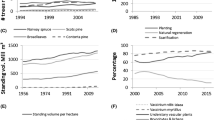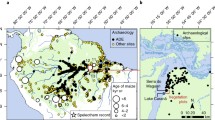Abstract
An ancient, sustainable, and low risk Colocasiataro monoculture has persisted until modern times among the Mountain Ok peoples of central New Guinea. There is a monoculture-polyculture axis in the region with taro monocultures predominant in the rain forests of the mid-altitude fringe. We argue that when examined from the standpoint of ecosystem simplification, biological variability, and subsistence vulnerability, the taro monocultures exhibit many ecological and systemic properties commonly attributed to polycultures. Monoculture is not an exclusive category; specific cases must be placed in a broader context of the larger ecosystem and the options people have at their disposal. Reduction of the taro monoculture is occurring in response to modernization pressures.
Similar content being viewed by others
References
Barth, F. (1975).Ritual and Knowledge among the Baktaman of New Guinea. Yale University Press, New Haven.
Bayliss-Smith, T. (1985a). Subsistence agriculture and nutrition in the Bimin Valley, Oksapmin sub-district, Papua New Guinea.Singapore Journal of Tropical Geography 6:101–115.
Bayliss-Smith, T. (1985b). pre-Ipomoean agriculture in the New Guinea Highlands above 2000 metres: Some experimental data on taro cultivation. In Farrington, I. S.ed.), Prehistoric Intensive Agriculture in the Tropics. B.A.R. International Series 232.
Beckerman, S. (1983). Does the swidden ape the jungle?Human Ecology 11: 1–12.
Bompard, J., Ducatillion, C., Racketsweiler, P., and Michon, G. (1980).A Traditional Agricultural System: Village-Forest Gardens in West Java. Universite des Sciences et Techniques de Languedoc, Academie de Montpellier, Montpellier.
Boster, J. (1983). A comparison of the diversity of the Jivaroan Gardens with that of the tropical forest.Human Ecology 11: 47–68.
Bourke, M. (1979). Report on a brief visit to Oksapmin sub-district to examine subsistence agriculture. High Altitude Experiment Station, Aiyura, Kainantu (mimeographed).
Brown, P. (1972).The Chimbu: A Study of Change in the New Guinea Highlands. Schenkman, Cambridge, Massachusetts.
Brown, P. (1978).Highland Peoples of New Guinea. Cambridge University Press, Cambridge.
Cape, N. (1980). Malnutrition in Oksapmin. Teaching Methods and Materials Centre, Occasional Paper No. 4, University of Papua New Guinea, Port Moresby.
Cape, N. (1981). Agriculture. In Weeks, S. (ed.),Oksapmin: Development and Change. Educational Research Unit, University of Papua New Guinea, Port Moresby, pp. 149–190.
Conklin, H. C. (1957).Hanunoo Agriculture: A Report on an Integral System of Shifting Cultivation in the Philippines. FAO Forestry Development Paper No. 12, Rome.
Connell, J. (1978a). The death of taro: Local response to a change of a subsistence crop in the northern Solomons.Mankind 11: 445–452.
Connell, J. (1978b).Taim Bilong Mani: The Evolution of Agriculture in a Solomon Island Society. Development Studies Centre Monograph No. 12, Australian National University, Canberra.
Craig, B. (1969). Houseboards and warshields of the Mountain Ok, Central New Guinea: Analysis of an art style. Unpublished M.A. thesis, Department of Anthropology, University of Sydney, Sydney, Australia.
Dasmann, R. F., Milton, J. D., and Freeman, P. H. (1973).Ecological Principles for Economic Development. Wiley, New York.
Dobra, B. (1983). Traditional agriculture in India: High yields and no waste.The Ecologist 13(2,3): 84–87.
Ewel, P. T. and Poleman, T. T. (1979). Uxpanapa: Resettlement and agricultural development in the Mexican Tropics. Cornell Agricultural Economics Staff Paper No. 79-10, Ithaca.
Flowers, N., Gross, D., Ritter, M., and Werner, D., (1982). Variations in swidden practices in four central Brazillian Indian societies.Human Ecology 10: 203–217.
Freeman, P., and Fricke, T. (1984). The success of Javanese multi-storied gardens.The Ecologist 14(4): 150–152.
Gagne, W. (1982). Staple crops in subsistence agriculture: Their major insect pests, with emphasis on biogreographical and ecological aspects. In Gressitt, J. (ed.),Biogeography and Ecology of New Guinea. Dr. W. Junk, The Hague, pp. 229–258.
Gardner, D. (1981). Cult ritual and social organization among the Mianmin. Unpublished Ph.D. dissertation, Department of Prehistory and Anthropology, Australian National University, Canberra.
Geertz, C. (1963).Agricultural Involution: The Process of Ecological Change In Indonesia. University of California Press, Berkeley.
Hames, R. (1983). Monoculture, polyculture, and polyvariety in tropical forest swidden cultivation.Human Ecology 11: 13–34.
Harris, D. (1971). The ecology of swidden cultivation in the upper Orinoco Rain Forest, Venezuela.Geographical Review 61: 475–495.
Healey, A. (1964).A Survey of the Ok Family of Languages. Australian National University, Canberra.
Hyndman, D. G. (1979). Wopkaimin subsistence: Cultural ecology in the New Guinea highland fringe. Unpublished Ph.D. dissertation, Department of Anthropology and Sociology, University of Queensland, Brisbane.
Hyndman, D. G. Biotope gradient in a diversified New Guinea subsistence system.Human Ecology 10: 219–259.
Hyndman, D. G., and Morren, G. E. B. Jr. (n.d.). The human ecology of the Mountain Ok (manuscript).
Igbozurike, M. (1971). Ecological balance in tropical agriculture.Geographical Review 61: 519–529.
Kass, D. (1978). Polycultural cropping systems: Review and analysis. Cornell International Agriculture Bulletin 32, Cornell university, Ithaca, New York.
Kunstadter, P., Chapman, E. C., and Sabhasri, S. (eds.) (1978).Farmers in the Forest: Economic Development and Marginal Agriculture in Northern Thailand. East-West Center, Honolulu.
Manners, H. (1981). Ecological succession in new and old swiddens in Montane Papua New Guinea.Human Ecology 9: 359–377.
Marten, G. G. (ed.) (1986).Traditional Agriculture in Southeast Asia: A Human Ecology Perspective. Westview Press, Boulder.
McNew, G. L. (1966). Progress in the battle against plant disease. InScientific Aspects of Pest Centrol. National Academy of Sciences, Washington, D.C., pp. 73–101.
Miracle, M. (1967).Agriculture in the Congo Basin. University of Wisconsin Press, Madison.
Mitchell, D. D. (1976).Land and Agriculture in Nagovisi, Papua New Guinea. Monograph No. 3. Institute of Applied Social and Economic Research, Boroko, Papua New Guinea.
Morren, G. E. B., Jr. (1977). From hunting to herding: Pigs and the control of energy in Montane New Guinea. In Bayliss-Smith, T., and Feachem, R. (eds.),Subsistence and Survival. Academic Press, London, pp. 273–316.
Morren, G. E. B., Jr. (1983). A general approach to the identification of hazards and responses. In Hewitt, K. (ed.),Interpretations of Calamity. Allen, & Unwin, London, pp. 284–297.
Morren, G. E. B., Jr. (1986).The Miyanmin: Human Ecology of a Papua New Guinea Society. UMI Research Press, Ann Arbor.
Morren, G. E. B., Jr. (n.d.). Why the Miyanmin are growing moreKaukau (manuscript).
Moylan, T. (1981). Some notes on change in the Oksapmin area. In Weeks, S. (ed.),Oksapmin: Development and Change. Educational Research Unit, University of Papua New Guinea, Port Moresby, pp. 61–68.
Neumann, I. F. (1983). Use of trees in smallholder agriculture in tropical highlands. In Lockeretz, W. (ed.),Environmentally Sound Agriculture. Praeger, New York, pp. 351–374.
Okigbo, B. N. (1981). Plants and agroforestry in land use systems of West Africa: A conceptual framework for planning and establishment of research priorities.Proceedings of Nairobi Consultative Meeting on Plant Research and Agroforestry, Nairobi.
Okigbo, B., and Greenland, D. (1976). Intercropping systems of tropical Africa. In Stelly, M. (ed.),Multiple Cropping. American Society of Agronomy Special Publication 27.
Oliver, D. (1955).A Solomon Island Society: Kinship and Leadership among the Siuai of Bougainville. Beacon, Boston.
Packard, J. (1975). The Bougainville taro blight. Pacific Islands Program, Miscellaneous Working paper No. 1, University of Hawaii.
Pearson, M., and Thistleton, B. (1981). Taro diseases in the Hotmin area, East Sepik Province, and the Telefomin area, West Sepik Province: Report of field visit, 1981. Konedobu, Department of Primary Industry, Papua New Guinea.
Perey, A. (1973). Oksapmin society and world view. Unpublished Ph.D. dissertation. Department of Anthropology, Columbia University, New York.
Pickett, S. T. A., and Thompson, J. N. (1978). Patch dynamics and the design of nature preserves.Biological Conservation 13: 27–37.
Poole, F.-J. P. (1976). The Ais Am: An introduction to male initiation ritual among the Bimin-Kuskusmin of the West Sepik District, Papua New Guinea. Unpublished Ph.D. dissertation, Department of Anthropology, Cornell University, Ithaca, N.Y.
Rappaport, R. A. (1968).Pigs for the Ancestors: Ritual in the Ecology of a New Guinea People. Yale University Press, New Haven.
Rappaport, R. A. (1971). The flow of energy in an agricultural society.Scientific American 225(3): 117–132.
Regan, C. (1983). Underdevelopment and hazards in historical perspective: An Irish case study. In Hewitt, K. (ed.),Interpretations of Calamity. Allen, & Unwin, London, pp. 98–120.
Reynders, J. (1962). Shifting cultivation in the Star Mountains area.Nova Guinea 10(3): 45–73.
Scheffler, H. W. (1965).Choiseul Island Societal Structure. University of California Press, Berkeley.
Soedjito, H. (1985). Succession and nutrient dynamics following shifting cultivation in Long Sungai Barang, East Kalimantan, Indonesia. M. A. thesis in ecology, Rutgers University, New Brunswick, N.J.
Swadling, P. (1983).How Long Have People Been in the Ok Tedi Impact Region? National Museum Record No. 8, Boroko, New Guinea.
Watson, J. B. (1977). Pigs, fodder, and the Jones Effect in Postippomoean New Guinea.Ethnology 16: 57–69.
Weinstock, J. A. (1984). Monoculture or polyculture in a swidden system.Human Ecology 12(4): 481–482.
Wilken, G. C. (1977). Integrating forest and smallscale farm systems in middle America.Agro-Ecosystems 3: 291–302.
Wortman, S., and Cummings, R. (1978).To Feed this World: The Challenge and the Strategy. The Johns Hopkins University Press, Baltimore.
Wrigley, G. (1969).Tropical Agriculture: The Development of Production. Faber & Faber, London.
Zeuner, T. H. (1981). An ecological approach to farming: Some experience of the agro-pastoral project, Nyabisindu, Rwanda. In Buck, L. (ed.),Proceedings of the Kenya National Seminar on Agroforestry. ICRAF, Nairobi, pp. 329–353.
Author information
Authors and Affiliations
Rights and permissions
About this article
Cite this article
Morren, G.E.B., Hyndman, D.C. The taro monoculture of central New Guinea. Hum Ecol 15, 301–315 (1987). https://doi.org/10.1007/BF00888028
Issue Date:
DOI: https://doi.org/10.1007/BF00888028




